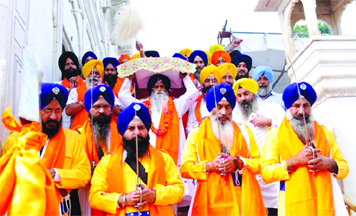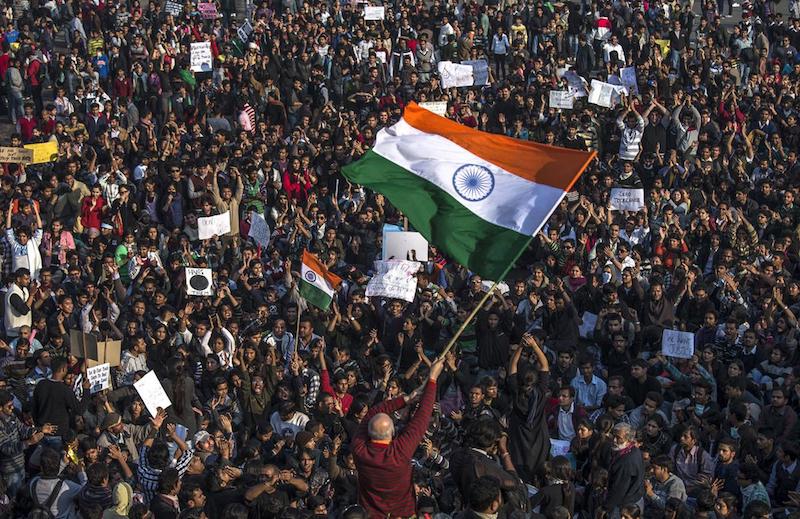
By Prof. Balwinder Pal Singh
Historically, it was on Vaisakhi day of 1699 A.D. when the tenth Master Guru Gobind Singh created Khalsa Panth out of the Sikh Sangat (GUR SANGAT KINI KHALSA). The creation of Khalsa is a virtual culmination of the process of human resource development started by the first Master Guru Nanak. That’s why the Sikhs call their Gurus: First Nanak, second Nanak and so on to salute them and to recall their heritage.
There has been some misconception among non-Sikhs, in particular, and to some extent, among the Sikhs also that the philosophy of the tenth Guru was different from that of the first and the subsequent Gurus. This impression is taken from the paintings of these Gurus. These show the difference of armed and unarmed personalities. The sixth, the seventh, the ninth and the tenth Guru waged an armed struggle against tyranny and repression. These were the battles for Dharma and not for any material or personal gains.
Sikhism is a revealed religion founded by Guru Nanak Dev (1469-1539 A.D.). The basic principles of Sikhism remained unchanged and intact from its very inception to its culmination in the hands of the tenth Guru. Guru Nanak raised his voice of protest against state repression, social injustice, religious hypocrisy and economic corruption. He traversed various corners of the world to spread his message of humanism. He rejected all divisions based on caste, creed and color.
Gurbani was the main source of spiritual power and awareness and a practical approach was followed in respect of social and political issues. Up to the fifth Guru, Sikh culture and institutions were developed in a phased manner. The compilation and emergence of the “Adi Granth’ was the greatest historical development in the hands of Guru Arjan Dev. The sixth guru, Guru Hargobind Sahib took to arms to protect dharma from state repression. He established the institution of MEERI-PEERI (saint soldier). In his times, nobody who was not pure and religious could join his army. A high moral standard was required for anybody aspiring to be a soldier in Guru Hargobind’s Army. Thus, right from the days of Guru Nanak the emphasis has been on righteousness and purity of personal conduct.
After the supreme martyrdom of Guru Teg Bahadur, Guru Gobind Singh raised his voice fearlessly against injustice and tyranny of Mughal king, Aurangzeb. This reaction was not the result of any personal grudge or enmity, it was based on the principle which is the cornerstone of Sikhism to fight against injustice. In fact, Guru Gobind Singh had himself suggested to his father to sacrifice himself for protecting Hindu religion and Kashmiri Pandits. Like Guru Hargobind, Guru Gobind Singh, too proved that Bhakti and Shakti are complementary and nor contradictory to each other. Bhai Gurdas Singh, a renowned contemporary Sikh scholar describes Guru Gobind Singh thus: “Behold, there manifests the incomparable Man, the Hero unsurpassed, Glory be to Gobind Singh, Master Disciple”.
Prof. Jaswant Singh writes about the tenth Guru “Rarely is found a person in the history of mankind who had left such a deep imprint on the life and character of people within a brief span of forty-two years. He still continues to move millions of men and women ‘not only I India, the great subcontinent of Asia but the entire world. Such a unique person was Guru Gobind Singh.
The image of God as portrayed by Guru Gobind Singh is exactly the same as painted by Guru Nanak Devji. The Mool Mantra of Japii Sahib and the first stanza of Jaar Sahib (poetic work of the tenth Guru) provide an interesting study from this point of view. The Almighty of Guru Gobind Singh is the “True Lord of All, has neither distinguishing signs nor marks, no one can discern him, the moveless being and beyond limitations, and is manifested as the Light of the Spirit, the Lord God of a myriad Indiras and is proclaimed the King of kings, the Master of three worlds, of the gods. man and demons…….
The eminent historian, Cunningham states that though the last apostle of the Sikhs did not see his own ends accomplished, he effectively raised the dormant energy of a vanquished people and filled them with a lofty although fitful longing for social freedom and national ascendancy, the true adjunct of that purity of worship which had been preached by Nanak.
Guru Gobind. Singh not only patronized the Sikh institution of sacrifice, he actually sacrificed his whole family. Guru Gobind Singh is an ideal and should be an idol for the young generation of today.
All pessimism will vanish and instead robust optimism will fill the youth should they imbibe the ideals and values of the Guru. Let them give up their weakness for intoxicants and have faith in their innate energy to countenance any challenge and overcome any obstacle.
Let them follow the Guru’s progressive humanism empowered with spirituality and sacrifice.
Let them derive strength and courage from the tenth Guru who expressed all optimism and positive attitudes for the victory of the forces of righteousness over evil and repression.
Sikh culture and religion is a rich heritage to be protected and glorified. The mission of Gura Nanak-Gobind Singh is cosmic. May the almighty Akal Purakh bestow His blessings on all human beings, particularly the young generation of the Sikhs and fill them with tremendous strength and will to establish the kingdom of God on earth.
(Republished with permission from Punjab Beat)





Be the first to comment